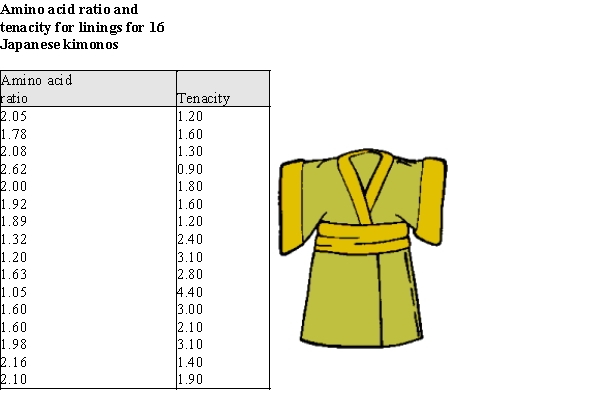Exhibit 4-1
The preservation of objects made of organic material is a constant concern to those caring for items of historical interest. For example, some delicate fabrics are natural silks--they are made of protein and are biodegradable. Many silks in museum collections are in danger of crumbling. It would be of great benefit to be able to assess the delicacy of the fabric before making decisions about displaying it. One possibility is chemical analysis, which might give some evidence about the brittle nature of a fabric. To investigate this possibility, bio-chemical data in the form of a ratio of the amount of certain amino acids in the fibers was acquired from the linings of sixteen 19th and early 20th century Japanese kimonos, and the tenacity (breaking stress) of the fabric was also recorded.
Using the data from the Japanese kimonos, construct the least squares best fit line predicting tenacity using amino acid ratio as a predictor. 
-Refer to Exhibit 4-1.
What is the equation of the least-squares line?
Definitions:
Causal Factors
Elements or conditions that can directly influence the occurrence or development of a phenomenon or outcome.
Population Efficacy
The effectiveness of a treatment or intervention when applied to a broad population under 'real-world' conditions.
Interventions
Actions or processes conducted to modify an outcome or conditions in a study or therapeutic context.
Random Sample
A subset of a statistical population in which each member of the subset has an equal probability of being chosen.
Q5: For stem and leaf plots with single-digit
Q6: Assuming the same sample size is used,
Q8: The second most common form of dementia
Q17: The marketing plan of an organization is
Q20: According to the article "The incidence of
Q23: Stimulating an autoreceptor will<br>A)result in seizure<br>B)result in
Q25: Assuming a random sample from a large
Q38: The estimated mean value of y is
Q57: Twenty-five assembly-line workers participated in a study
Q115: Initiatives intended to improve an organization's positive